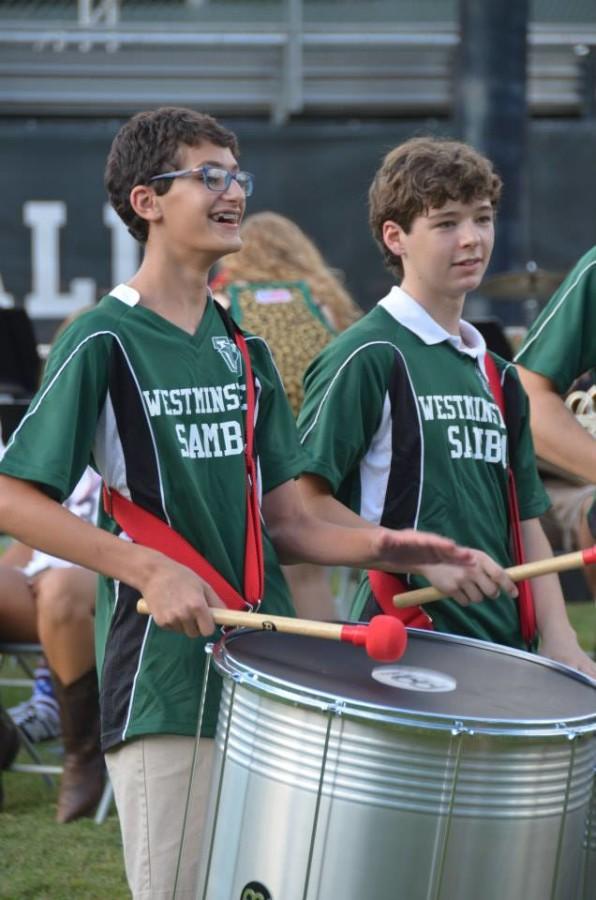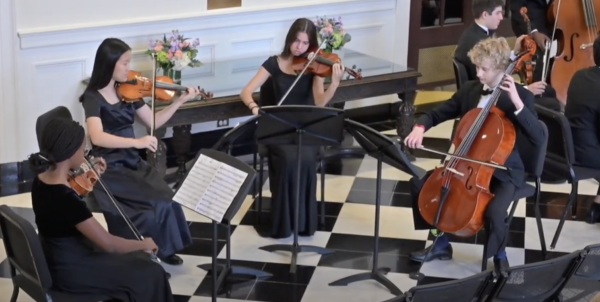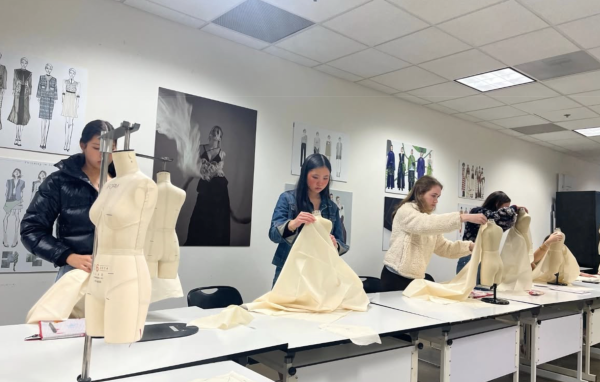Samba band provides fresh take on percussion, entertains
Westminster by Upper School instrumental music director Scott Stewart, is composed of percussion players in the Westminster band who publicly perform as a group. After Samba’s success at his previous school, Stewart thought the Brazilian-influenced music was a perfect type of drumline for high schools and wanted to continue it at Westminster.
“Since a marching band is just about as soul-sucking as it gets,” said senior Samba bandmember William Denning, “things like Samba help add a fresh take on standing percussion performance.”
Customarily, Samba consists of string instruments such as cavaquinho, as well as members of the percussion family, like the tamborim. However, American inspiration led to the use of trombones, trumpets, choros, flutes, and clarinets in Samba. In Westminster’s Samba band, the percussion players strive to echo this unique part of Latin American culture by incorporating many of these instruments into their performances. Many students are not accustomed to playing these instruments, so the Samba band allows members to broaden their musical range.
“We play all of these Brazilian drums,” said sophomore member Creed Beavers.
Modern Samba is mostly in a 2/4 tempo and was developed in the early 20th century. This fast beat of Samba is unfamiliar to many students and creates a unique air to the percussion band.
“My favorite part of the Samba band was listening to the cool beats,” said sophomore and previous Samba band member Luke Jones. “We only played one song, but it was really interesting.”
The Brazilian music provides a link between students and Latin America. The nature of Samba allows students to be flexible in the types of musical pieces that they play and the way they structure their band. Samba bands are also unique based on the members and its location.
“Samba gives a great gateway into Brazilian culture,” said Denning. “No Samba band is the same, and each has their routines, yet requires no sheet music.”
Samba connects some ethnically Brazilian students to their heritage. It combines Brazilian culture with African culture as in imperial Brazil, the West African slave trade (predominantly in Angola and the Congo) brought African religious customs and culture to South America. The abolition of Brazilian slavery in 1888 caused a migration of liberated slaves to Rio de Janeiro, the capital of the new republic. The freed slaves brought their music styles with them. In an effort to preserve their culture in the face of discrimination, the Afro-Brazilians developed rhythms that eventually led to Samba. Today, numerous styles of Samba exist throughout Brazil through specific beats and provincial dances, but the overall genre of Samba is generally considered a product of Rio de Janeiro.
“I love Samba because it’s Brazilian music and I’m Brazilian,” said senior Samba band member Gabi Barros.“It’s really exciting to play something from my own culture.”
Samba also brings the members of the Samba band together, as it is a smaller group of students from the Upper School band that have a passion for this type of music. The members feed off of each other’s performances and instruments to create an ensemble sound that is unlike anything other musical group at Westminster.
“Everyone’s music builds on each other and it builds a connection,” said Jones. “There is definitely an unbreakable connection between the members.”
In Samba, Denning usually plays the repinique, a tom-like drum played at a variety of pitches. Traditionally, the repinique leads the band with the “calls,” eliciting the “response” by the ensemble. Any member of the band could play any of the instruments, which allows for flexibility in their roles.
“I [also] play the repinique,” said Barros. “I think it’s super fun.”
The Samba band has played at football games, pep rallies, and assemblies. This has allowed a different culture and tradition to participate in the daily life of Westminster campus.
“We also played at the Pigskin Picnic, which was personally my favorite performance,” said Beavers.
Overall, Samba has had a positive effect on the band.
“I think everyone really likes it,” said Barros. “It can be stressful when learning everything but when we get into the groove, everyone enjoys it.”
Not only a hit with the percussion players themselves, the Samba band has found popularity with the school community.
“Students love Samba almost as much as we do,” said Denning. “We are excited to begin performing at more events.”
Students have found the Samba band engaging, entertaining, and interesting to listen to.
“I really enjoyed listening to the Samba band play,” said sophomore Zach Hay. “I find Brazilian culture and music really fascinating, and it was so cool to hear it from my peers.”
Many aspects of the Samba band were popular with students.
“Not only is the music really cool, but the history behind it is cool, too,” said sophomore Jackson Alexander. “I love music in general, so to me, the combination of rhythmic beats and history makes Samba really special and unique.”
The student body anticipates the opportunity to hear more of the Samba band.
“I really look forward to hearing more Samba songs in the future,” said Hay. “I hope they have an assembly to show off their hard work.”




